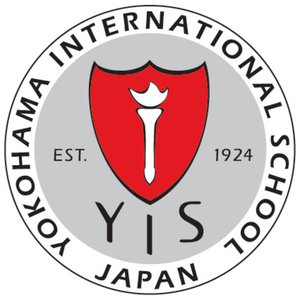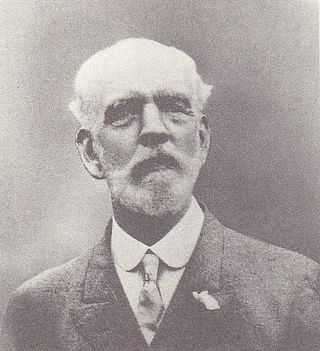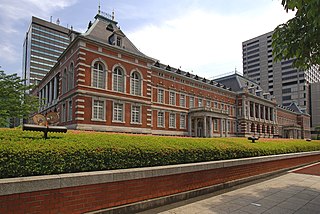
Yokohama is the second-largest city in Japan by population and the most populous municipality of Japan. It is the capital city and the most populous city in Kanagawa Prefecture, with a 2020 population of 3.8 million. It lies on Tokyo Bay, south of Tokyo, in the Kantō region of the main island of Honshu. Yokohama is also the major economic, cultural, and commercial hub of the Greater Tokyo Area along the Keihin Industrial Zone and two Californian sister city partnerships of San Diego (1957–2021) and San Francisco are located in the West Coast of the United States.

Yamate (山手) is the name of a historic neighbourhood in Naka-ku, Yokohama often referred to in English as The Bluff. The neighbourhood is famous as having been a foreigners' residential area in the Bakumatsu, Meiji and Taishō periods. While still dominantly residential in character, with views over downtown Yokohama, historic residential properties, ornamental gardens and public parks, the area is also a popular visitor destination.

The foreign cemeteries in Japan are chiefly located in Tokyo and at the former treaty ports of Kobe, Hakodate, Nagasaki, and Yokohama. They contain the mortal remains of long-term Japan residents or other foreigners who died in Japan, and are separate from any of the military cemeteries.

Yokohama International School (横浜インターナショナルスクール) is a co-educational international school located in Naka-ku, Yokohama, Japan.

Naka-ku (中区) is one of the 18 wards of the city of Yokohama in Kanagawa Prefecture, Japan. In 2010, the ward had an estimated population of 146,563 and a population density of 7,080 persons per km². The total area was 20.86 km².

Yokohama Chinatown is located in Yokohama, Japan, which is located just south of Tokyo. It is about 160 years old, with a population of about 3,000 to 4,000. Today, only a few Chinese people still live there, most being from Guangzhou.

Sakuragichō Station is an interchange passenger railway station located in Naka-ku, Yokohama, Japan, operated by East Japan Railway Company and the Yokohama Municipal Subway.

Kannai (関内) is a district in Naka Ward, Yokohama, Japan, bounded by the Ōoka River, JR Negishi Line, Nakamura River, and Yokohama waterfront. "Kannai" is not an official name of the area, but the common term of reference has been in use for over a century.

Sacred Heart Cathedral is the seat of the bishop of the Roman Catholic Diocese of Yokohama, Japan. The Yokohama diocese includes Kanagawa, Shizuoka, Nagano, and Yamanashi prefectures. As it is located at 44 Yamate-cho, Naka-ku, the cathedral is commonly known locally as Yamate Catholic Church.

Josiah Conder was a British architect who was hired by the Meiji Japanese government as a professor of architecture for the Imperial College of Engineering and became architect of Japan's Public Works. He started his own practice after 1888.
The Negishi Housing Complex was an enclave of United States Forces Japan operated by United States Fleet Activities Yokosuka in Yokosuka, Japan. It served as a residence complex for the U.S. military.
The Gaiety Theatre is a public hall in Naka-ku, Yokohama, Japan. It was built in 1866 by Dutch merchant MJB Noordhoek Hegt behind his office at Settlement plot 68. An amateur dramatic club was organized and performed at the public hall. Hegt rented the hall at a very reasonable price for the dramatic club's performances but it soon proved to be too small and was also being used for many other activities so, in 1870, another small theater was built on Honmachi Street and became the original Gaiety Theatre.

The British Embassy, Tokyo is the chief diplomatic mission of the United Kingdom in Japan, with the Ambassador of the United Kingdom to Japan being the chief of mission. The embassy compound measures about 35,000 m2, located at No 1 Ichibanchō, Chiyoda-ku, Tokyo, to the west of the Imperial Palace, and separated from the latter by a moat.

Christ Church, Yokohama, is a historic Anglican church located in Yamate, Yokohama, Japan. Providing a center of worship for both Japanese and English-language congregations the church traces its foundation to shortly after the formal opening of the treaty port of Yokohama in 1859.

James McDonald Gardiner was an American architect, lay Anglican church missionary and educator who lived and worked in Japan during the Meiji period.

Negishi Racecourse was a horse-racing facility located on the outskirts of Yamate in the treaty port of Yokohama, recognized as the first purpose built European style racecourse in Japan. The course was operational between 1866 and 1942.

Ferris Girls' Junior & Senior High School is a junior and senior high school for girls in Yokohama. It is a part of Ferris Jogakuin.

Cluden Racecourse is a heritage-listed racecourse at 1 Racecourse Road, Cluden, City of Townsville, Queensland, Australia. It was designed by Walter Howard Tunbridge and built in 1896 by Mr Reid. It was added to the Queensland Heritage Register on 21 October 1992.

Eagle Farm Racecourse and Ascot Railway station is a heritage-listed pair of racecourse and railway station at 230 Lancaster Road, Ascot, City of Brisbane, Queensland, Australia. It was built from 1863 onwards. The racecourse is also known as Ascot Racecourse and Brisbane Racecourse, and Ascot railway station was previously known as Racecourse railway station. It was added to the Queensland Heritage Register on 25 June 2004.

The Old Ministry of Justice Building (法務省旧本館), also known as the Red-Brick Building (赤れんが棟), is an historical building in the Kasumigaseki district of Chiyoda, Tokyo, Japan. It previously served as the headquarters of the Ministry of Justice and continues to house certain offices of the ministry. It is designated as an Important Cultural Property.


















